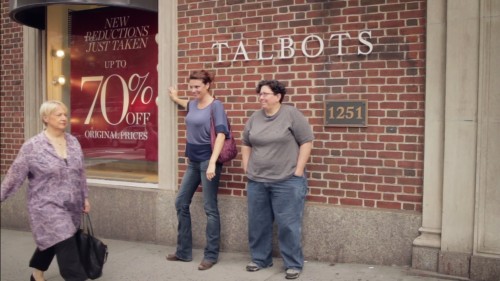This guest post by Tessa Racked appears as part of our theme week on Fatphobia and Fat Positivity.
This article contains spoilers for The Foxy Merkins.
Selected for the NEXT series at the 2014 Sundance Film Festival along with films like Obvious Child and A Girl Walks Home Alone at Night, The Foxy Merkins is a comedy by and about queer women with an episodic structure and humor fueled by social awkwardness and mundane absurdism (think Louie). Simply put, it’s part fish out of water comedy, part buddy film, and all lesbian hookers. Set in contemporary New York City, the film creates a world of sex work in homage to Midnight Cowboy and My Own Private Idaho, but populated by women who have sex with other women. As with its progenitors, this subculture is scandalous, but hardly clandestine. These sex workers bide their time on the sidewalk in broad daylight until approached by other women, which occurs with relative frequency.
The film charts unexpected territory by merging stereotypes about seemingly disparate subcultures. Its narrative maintains the beats of taboo sex and danger expected from a story about sex workers, but does so through the filter of lesbian culture and stereotypes. In one exchange between the two main characters, Jo (Jackie Monahan) advises Margaret (Lisa Haas) to market her services by using the hanky code. However, the film’s version isn’t quite the same one used by gay men in the 70s to signify their kinky preferences: “A yellow bandana in your left back pocket means you have more than one cat… a red bandana in your right back pocket means you like women who have been through the Change.”

The film predominantly focuses on Margaret, a newbie sex worker with a degree in Women’s Studies who happens to be fat and butch. She is a pastiche of red-blooded hunk Joe Buck (Jon Voight) from Midnight Cowboy and sulky sylph Mike (River Phoenix) from My Own Private Idaho, but her size and gender expression set her apart from their more normative representations of beauty. That separation is reinforced by much of the film’s comedy, but Margaret isn’t positioned as an object of ridicule or disgust, as is often the case with fat and/or gender non-conforming characters. She is naive, gauche, and in over her head, but she is also the character with whom the audience empathizes most.
Margaret bumbles her way through interactions with clients, but this characteristic diverts from the standard depiction of fat and/or gender non-conforming women as undeserving of sexual desire. The Foxy Merkins uses a more nuanced approach. We do see glimpses of her as a sexual being, such as a scene that begins by implying she’s just had an orgasm, even if it quickly turns its focus on her awkwardness. This trait is partially inherited from Joe Buck, who isn’t genteel enough to seduce the rich Manhattanites he targets. It’s charming in its relatability: as someone who can barely navigate small talk in a professional setting, let alone a sexual encounter, I could easily see myself in Margaret’s shoes. But these scenes are also ground for meta-humor, as film trope clashes with cultural expectations. What happens when someone who looks like Margaret assumes the role of soul-searching hustler formerly and famously occupied by normatively attractive men? The Foxy Merkins’ predecessors supply setting, story, and characters, but like a Warner Brothers cartoon character running off their background onto a blank screen, there is a dearth of precedent for a fat, butch film character to communicate sexual allure, either to fellow characters or to an audience who has been groomed to lust after thin, feminine women. The energy that Haas brings to these scenes suggests an undercurrent of resigned bewilderment.
Margaret socially functions as a sexual being by virtue of existing within a subculture of lesbian sex work, but that subculture largely retains real-world beauty standards, rendering her body simultaneously unattractive and sexually commodified. Jo explains to Margaret how she is seen by potential clients: “You’re the type of lesbian they are mortified to be seen with… they do not want to be caught with you. So they’re gonna pay you extra to sneak around with them… honestly, you should have so much more money.” Thin, femme Jo takes on the role of Margaret’s docent, as well as her foil. Carefree (and often careless), Jo opts to do sex work as a way of rebelling against her wealthy upbringing. Despite repeatedly stating that she is not sexually attracted to women, she is more experienced and successful than Margaret in their profession. In one scene, the two walk down a busy Manhattan street as Jo casually claims to have slept with every woman they pass, while Margaret seems to barely keep up with mentally processing what her friend is telling her.

The film continues to grapple with the clashing expectations of Margaret’s profession and appearance through a sequence of encounters with a rich, conservative client (Susan Ziegler). During their first encounter, the client asks Margaret to take her clothes off. In opposition to the sexy tone she ought to set, she chastely removes her bra and underwear once she is under the bedsheet. (Her client coquettishly refers to this maneuver as a “magic trick.”) While another film might construct an erotic scene with gliding closeups and sensual music, this one involves a stationary shot of Margaret squirming and rocking under the sheet as her client waits patiently off to the side, amplified sounds of rustling cloth the only soundtrack. The scene self-consciously buys into the mainstream trope that “nobody wants to see” fat bodies or expressions of queer sexuality. The client obviously wants to see Margaret’s body and have sex with her, but Margaret remains in her culturally sanctioned role of chaste lesbian/unseen fat person to the point of absurdity.
Unsurprisingly, this is not a film that passes up a chance to satirize the right wing. Margaret’s aforementioned client has hired two men (Charles Rogers and Lee Eaton) to dress as cops, burst into her hotel room, and terrorize Margaret, who is unaware that the scene is staged. In the second of three scenes to this effect, Margaret is completely naked. Fat bodies in a state of undress are usually cause for a film protagonist to express disgust, with the expectation that the audience will empathize with that disgust. This time, however, the fat body belongs to our protagonist. She isn’t modestly positioned with her back to the camera or cheekily blocked by an object in the foreground. The audience sees her full frontal in the center of the screen, flanked by the two cops pointing guns at her. As with her “striptease,” the camera is unwavering. This static view heightens our sense of Margaret’s shock and embarrassment, but is also confrontational. This is a film that asks the audience to relate to a fat, lesbian protagonist: if a viewer has been trying to empathize with Margaret by downplaying her size or queerness up to this point in the movie, those characteristics have become starkly unavoidable.
The male gaze that reinforces standards of thinness and straightness and is ubiquitous in cinema, even if only present in a handful of scenes in The Foxy Merkins, is embodied in this scene by the two cops. They repeatedly tell Margaret to drop what she’s holding, despite her protests that she isn’t holding anything and attempts to placate them by making dropping motions with her empty hands. They even insist that she has “something tied around [her] waist” and is wearing “a collared shirt,” as if they have no sense of what a fat woman’s body looks like in the nude. An absurdist feedback loop is created of a command that cannot be followed and cooperation that is inherently uncooperative. This dynamic is reminiscent of the often frustrating relationship that queer and fat people have with a dominant culture that demands compliance even when attempts to do so are demonstrably futile. We still hear voices of authority telling us to “drop it” with regards to weight and desire for non-heteronormative love and sex, despite evidence that diets don’t work in the long run and sexual orientation can’t be changed at will.
But these two men have no genuine authority, they have been ordered to act as police by the client. As Jo later explains to Margaret, “It’s her fetish, it’s her kink. She likes to see people naked with the police.” The client watches these confrontations from behind the bedsheets, distancing herself from the situation by feigning shock and claiming that Margaret showed up in her room uninvited. This rich, white, thin woman who is hiding her own queerness to maintain her privilege actively seeks pleasure from seeing the oppression of marginalized people. Their third date even includes a Black woman, ostensibly the client’s maid, getting shot by the cops. Jo, who has the privileges of her appearance and wealthy upbringing, similarly benefits from the situation, as she has been paid to withhold from Margaret that the scenes aren’t real. The client’s fetish parallels the common use of schadenfreude in film to entertain at the expense of not only fat people, but people of color, sex workers, and queer, trans, and gender nonconforming people.
Of course, The Foxy Merkins is a comedy, and the scenarios it presents are not as cruel as the realities it satirizes, or even the films to which it pays homage. The pretend bust is the closest Margaret comes to experiencing violence on the job, and even that ends with the cops and their shooting victim laughing and walking offscreen together. Nevertheless, the lighthearted humor speaks to real disparities in media representation. The audience is not allowed to forget that Margaret is occupying a position that the film industry did not historically intend to include someone of her sexuality, gender expression, or size. Both as a lesbian hooker and as a film character, her existence is a struggle. She ultimately realizes that she must move on from the former role, but as the latter, she is a quiet triumph.
Tessa Racked is a Women’s Studies major who makes a living as a social worker, writes about fat representation in film at Consistent Panda Bear Shape, and dispenses witticisms @tessa_racked. They live in Chicago.









